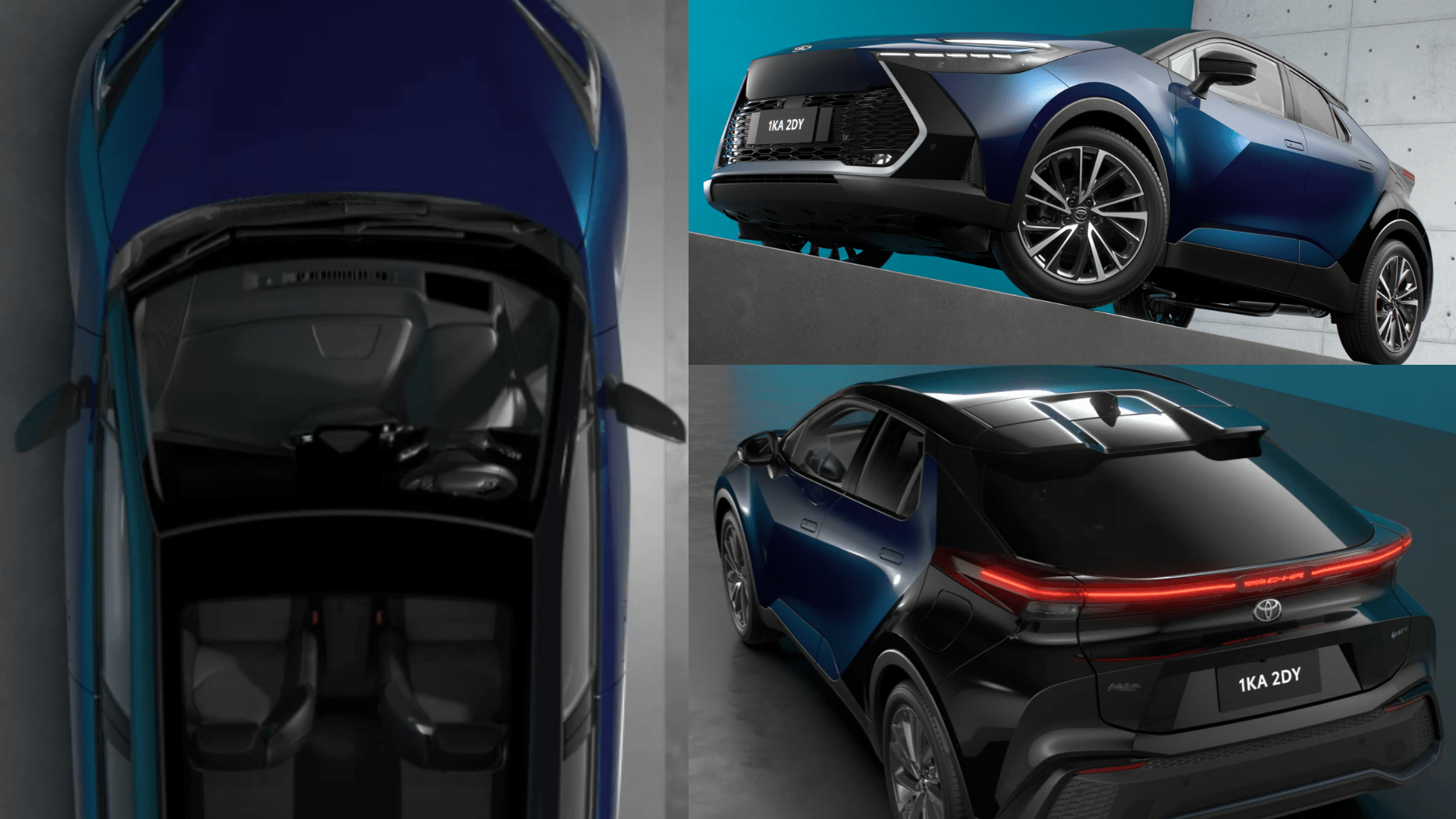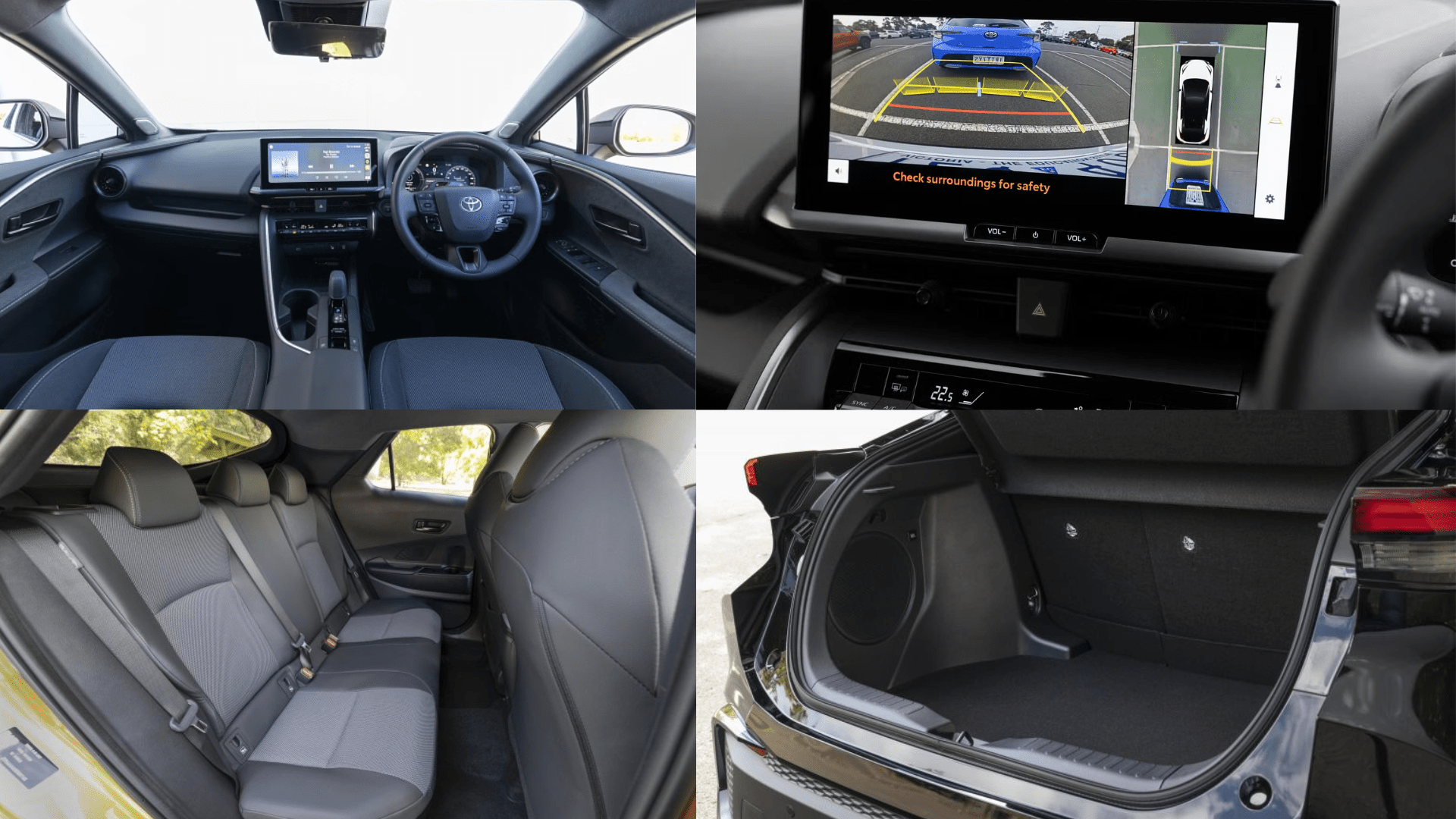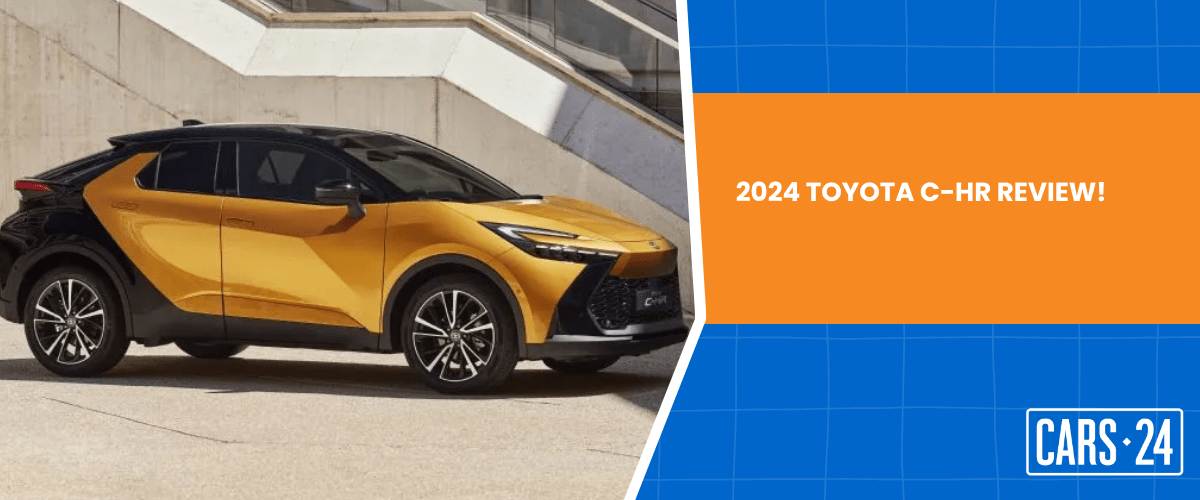Pros
- The exterior design is immaculate.
- A turning radius of 11.6 meters.
- Nanoe™ X air conditioning technology.
Cons
- Toyota’s app suite is restricted in usage.
- Voice recognition doesn’t work well.
- The rear windows are tinted and small which makes the car not get a lot of natural light.
- CVT box is loud.
What’s new about the Toyota C-HR?
- The headlight cluster has been updated.
- Two-tone colour options
- Design and engineered in Europe
- Toyota’s fifth-generation Hybrid Electric System
The big problem of the C-HR is the segment competitors which are considerable and have already created a space for themselves, like the Hyundai Kona, Mazda CX-30 and Nissan Qashqai. Incidentally, the car is just as big as the Qashqai.
| Variant | Price | Fuel Efficiency | Fuel Type |
|---|---|---|---|
| Toyta C-HR GXL | $47,746 | 4.0 L/100 Km | Petrol – Hyd |
| Toyta C-HR Koba | $55,640 | 4.0 L/100 Km | Petrol – Hyd |
| Toyota C-HR GR Sport | $60,850 | 4.1 L/100 Km | Petrol – Hyd |
Exteriors
Rating – 7/10

Styling Elements of Toyota C-HR
The styling elements are quite decent. The car holds is true form with subtle new tech added onto the old designs which makes it more prominent to function and easy to use. The headlight cluster is now entirely LED with LED DRLs situated at the undereye part of the headlights. Now while the front grille is quite big with robust finishes it still has fun-looking ticks. Apart from that, there are air inlets which are properly joined under the hood which gives it a very functional and fun look which works for the Australian consumer looking to get a coupe which isn’t a coupe.
Now while the design language from the side of the car will try to convince you that this is a coupe, as the frame and the design lines seem to merge, don’t be fooled, we’re yet to sit in it. Apart from that, other elements are read taillights which are LED as well, there’s an inbuilt spoiler and the entire back of the car is quite high which eases putting luggage in and out.
Colour Options of Toyota C-HR
There are quite a lot of colour options with the Toyota C-HR. The GXL model comes in Glacier White | Stunning Silver | Emeraldine | Frosted White | Graphite | Ink.
The Toyota C-HR Koba and Toyota C-HR GR Sport variants are where you can have fun with 7 single tones and 6 dual-tone colours.
Single tone colours are – Graphite | Ink | Feverish Red | Frosted White | Stunning Silver | Emeraldine | Sunglow
Dual-tone colours are – Graphite with two-tone plus | Feverish Red with two-tone plus | Frosted White with two-tone plus | Stunning Silver with two-tone plus | Emeraldine with two-tone plus | Sunglow with two-tone plus
Wheel Design of Toyota C-HR
The wheel designs are pretty standard. However, the simple chrome accents fashion each wheel design. The C-HR is offered in 17-inch, 19-inch and 20-inch. However, while the biggest wheel does add onto the style, the 19-inch alloy wheels look natural on the C-HR. The entry levels only get a standard 17-inch but they can also be upgraded to bigger wheels and better seams.
Interiors
Rating – 7/10

Interior Layout & Space in the Toyota C-HR
The entire layout of the C-HR seems to be based off off minimalism. The dashboard lines try to reiterate that this is a smooth-flowing high-rider even the contouring supports the same. The interior fabric is piano black with some chrome accents added to the beauty of the interior. The overall interior of the car feels premium when compared to the likes of the Hyundai Kona, it seems ages ahead and also has some very smooth and comfortable touch surfaces apart from the seats.
The build quality has some issues on the centre console storage and maybe the infotainment screen if rattled, apart from that Toyota is known for its build quality which will stay with you decades after you’ve invested in it.
Comfort & Ergonomics of Toyota C-HR
The three variants of the C-HR come with three different types of comfortable upholstery.
Sporty fabric front seats for ther GXL variant, Premium sport suede and fabric seats for the Toyota C-HR Koba and Toyota C-HR GR Sport suede and leather accented seats for the Toyota C-HR GR Sport variant.
Talking about the comfort in the second row, it is far roomier than what you’d expect it to be from the outside, the smaller than usual entry doesn’t win any confidence and it isn’t until you’re seated you realise that there is a space to sit comfortably. Ofocurse there isn’t room for you to anxiously tap your feet but then again not so little space that you have to crunch in to get in. But that’s about it for the second row, then the second row is more barren than the desert.
Boot of the Toyota C-HR
Now while the SUV-esque-looking car might want to throw your expectations off for a spin, boot is somewhat of a relief or somewhat of a redeeming quality. Mind you the 388 litres of boot space isn’t a lot, Qashqai and Kona run circles around the C-HR but given the shape which extends into the body of the car, it is able to store suspiciously more than you’d anticipate it.
Under the boot floor, there is a space saver tyre which elevates further the bootspace. However, if you want you can expand the boot space to over 1100 litres which makes it a considerable space for two people out and about the country.
Technology & Infotainment
Rating – 8/10
Toyota has been committed to making technology accessible at an exceptionally affordable rate. The Toyota C-HR only makes progress in that idea and gives the riders a considerable suite of technology and infotainment options.
Technology Features of the Toyota C-HR
- Dual-zone climate control
- Radar cruise control
- Blindspot monitoring system
- Automatic dimming rear vision mirror
- 3 level cup holder settings
- Adaptive cruise control with Lane keeping assist
- HUD display
- 64 ambient lighting colours
- Efficient ‘EV mode’
Connectivity Options of Toyota C-HR
- 12.3-inch infotainment screen
- Wired Android Auto and Apple CarPlay
- Voice recognition system
- 6-speaker sound system
- 12.3-inch driver display (Multi-information display)
Performance & Engine
Rating – 7/10
The Toyota C-HR is tuned to provide excellent performance while still maintaining great grip on erratic roads. The Toyota C-HR GR Sport variant has a 2 litre engine which generates 195 Bhp of power and 188 Nm of torque. This is the strongest engine you can get out of your C-HR. However the lower and middle level variants just one engine specification which is a 1.8 litre engine generating 138 Bhp of power and 142 Nm of torque. Needless to say that this specification won’t be discernable as long as you’re driving the Toyota C-HR within city limits.
Engine Specifications of the Toyota C-HR
| Variant | Power | Torque | Engine Configuration |
|---|---|---|---|
| Toyota C-HR GXL | 103 kW | 142 Nm | 1.8L 4-cylinder Hybrid |
| Toyota C-HR Koba | 103 kW | 142 Nm | 1.8L 4-cylinder Hybrid |
| Toyota C-HR GR Sport | 146 kW | 188 Nm | 2.0L 4-cylinder Hybrid |
Transmission & Drive System of the Toyota C-HR
On low speeds C-HR drives exceptionally well entirely powered on electric but pushing it over 30km/hr will shift it to the internal combustion engine. Now the switch or the transition is very subtle, you’ll be able to discern the speed and ofcourse the EV light on the dashboard will go away but the sound is how you’ll find out that you’ve shifted up.
The CVT gearbox starts to drone on when the accelerator is pushed, this causes the cabin to be considerably noisy. What confuses us is that the Honda HR-V has the same CVT gearbox and the cabin noise isn’t a complain from that vehicle. What did Honda do differently and what should Toyota do about it?
Braking System of the Toyota C-HR
The braking system is by far the most fine-tuned feature of the C-HR. The HEV’s braking system, which is essentially a disc brake mechanism, can be a bit grabby at times, but the PHEV braking system, which has the more common drum brake system, is tuned to perfection. They’re extremely strong and surprisingly smooth.
Fuel Economy & Efficiency of the Toyota C-HR
Rating – 8.5/10
The Toyota C-HR in Australia boasts impressive fuel efficiency thanks to its hybrid powertrain across all trim levels. The GXL and Toyota C-HR Koba models achieve an outstanding combined fuel consumption figure of 4.0 liters per 100 kilometers. This translates to excellent fuel economy, especially in city driving and stop-and-go traffic situations. The top-spec Toyota C-HR GR Sport, while featuring a more powerful hybrid system with all-wheel drive, still delivers a respectable 4.1L/100km. This slight increase is likely due to the larger 2.0-liter engine and additional electric motor. Overall, the Toyota C-HR excels in fuel efficiency, making it a cost-effective option for Australian drivers who prioritize low running costs and environmental friendliness.
Handling & Driving Dynamics of the Toyota C-HR
Rating – 8/10
The entire car sits on a TANG frame which is shared by the Toyota Prius and many other cars. This is just an added feature to make the drive compelling and comfortable. It isn’t the fastest of the cars in its segment, doesn’t have an impressive pick-up speed but moves very effectively and responds well to the driver.
Even at faster speeds and on curvy roads, the driving seems wonderful. The light steering keeps the responsiveness active which makes the overall driving experience extremely fun. What ruins the experience is the CVT gearbox which is noisy and unresponsive. The speeds of the car seem to be disabled by the mediocre gearbox.
In comparison, we feel that Ford Puma has a better punch and hook to it.
Safety Features
Rating – 8/10
This car is heavy on safety. If you’re feeling notorious and you switch off some of the ADAS features, they’ll only remain quite till you restart your car. After restarting, the safety features and set to default which makes your drive even more responsible.
- Autonomous emergency braking with pedestrian recognition
- 10 SRS airbags
- Blind Spot Monitor with Safe Exit Assist
- Rear Cross Traffic Alert
- Immobiliser and alarm
- Panoramic View Monitor
- Parking Support Brake (PKSB)
- Intelligent Park Assist
- Driver Monitor Camera
- Anti-lock Braking System with Electronic Brakeforce Distribution and Brake Assist
- Vehicle Stability Control and Traction Control
- Hill-start Assist Control
Advanced Safety Features of the Toyota C-HR
- Road Sign Assist
- Pre-Collision Safety System
- Lane Trace Assist
- Intelligent Adaptive Cruise Control
- Blind Spot Monitor
- Automatic High-beam System
Crash Test Ratings
The Toyota C-HR had been awarded a 5-star rating which expired in December 2023. The new ANCAP report is still awaited but the manufacturing year of the C-HRs that were made in 2023 makes it legitimate to sell in Australia and the car’s safety is also feasible.
- Adult Occupant Protection – 87%
- Child Occupant Protection – 77%
- Vulnerable Road User Protection – 65%
- Safety Assist – 68%
Ownership Experience
Owning a Toyota C-HR can be a satisfying experience, particularly for drivers seeking a stylish and fuel-efficient crossover. The comfortable cabin offers ample space for passengers, making it suitable for everyday use. The hybrid powertrain maybe standard but delivers excellent fuel economy, contributing to lower running costs. The infotainment system, while user-friendly, might feel slightly dated in older models compared to newer ones with larger touchscreens over 12 inches and smartphone integration features. Additionally, some owners of older C-HRs have reported experiencing a slightly firm ride quality, which has been improved in newer models with potential suspension tweaks. Overall, the C-HR offers a practical and reliable ownership experience, with newer models potentially benefiting from improvements in technology and ride comfort.
Major Drawbacks of the Toyota C-HR
- One USB port that can’t be used for charging if you’re using Android Auto or Apple CarPlay.
- No Digital Radio. It is standard in most of the cars at this point and at this price.
- No centre armrest, no door pockets, no mat pockets, no rear air vents, single USB C port, no rear window wiper and a single 12V outlet.
- The refresh rate on the driver display is a bit slow and lags, not the best place to put in a laggy screen.
Major Strengths of the Toyota C-HR
- Interior styling highlights give a temperament to the car.
- Entry-level model gets ample amounts of technology.
- The 2.0 litre engine seems to make up the lacklustre of driving power.
Maintenance & Warranty Information
Every new Toyota is covered by a five-year warranty, with unlimited kilometres as long as your vehicle isn’t used for commercial purposes. Keep up the annual service schedule, and Toyota extends your engine and driveline warranty from five to seven years.
Toyota keeps the cost of your annual service at a capped price for the first 3 of 5 years, depending on the model. In addition to that, Toyota offers the Toyota Warranty Advantage Extended Engine and Driveline coverage for 7 years from your vehicle’s first registration date, provided your vehicle is properly serviced and maintained per its Warranty and Service Book.
| Aspect | Rating |
| Exterior | 7 |
| Interior | 7 |
| Technology & Infotainment | 8 |
| Performance & Engine | 7 |
| Fuel Efficiency & Range | 8.5 |
| Handling & Driving dynamics | 8 |
| Safety features | 8 |
Verdict
Now while the new Toyota C-HR isn’t a half-bad car, this seems mostly for urban commuting only. Infact my issues arise from the point that if a car isn’t equipped with an AWD and a certain grade of suspension, with such a low ground clearance and considerable turning radius, can we even call it a Coupe-High Rider?
I wouldn’t care for it, this car is just too many contradictions on wheels. Now while crunched space in the second row isn’t my concern with this one, the lack of details and features in the secondro makes me want to run away. Sure the infotainment screen and speakers are all set to rock along and the cockpit seems to be quite easily accessible by all. I don’t know, maybe I’ll keep this car in consideration before making my decision but yes, I wouldn’t suggest you to rush to buy this.
